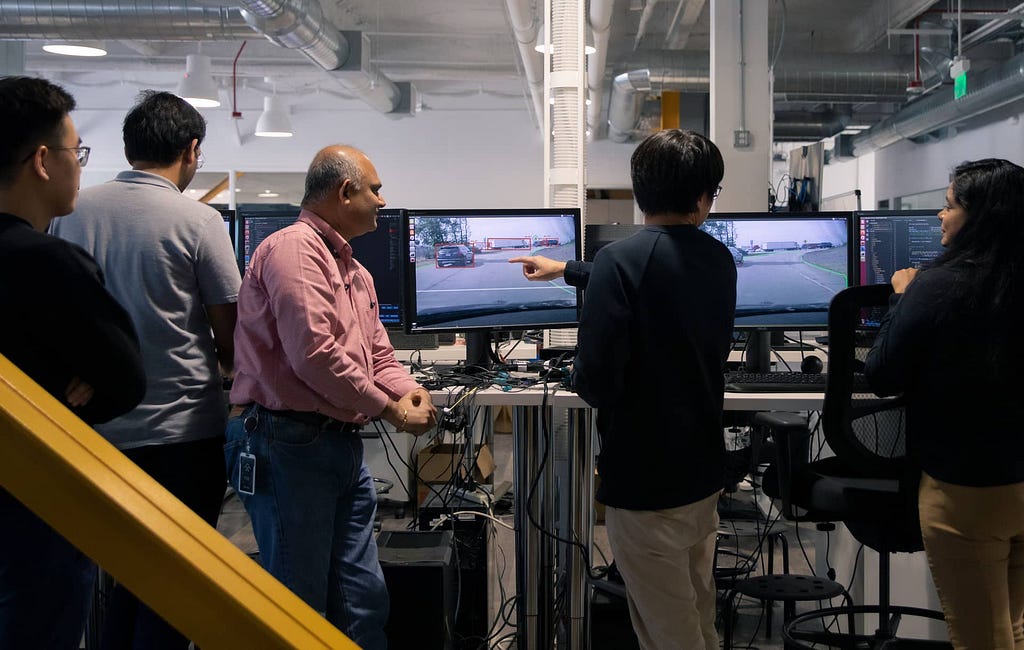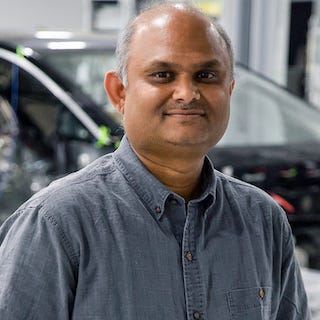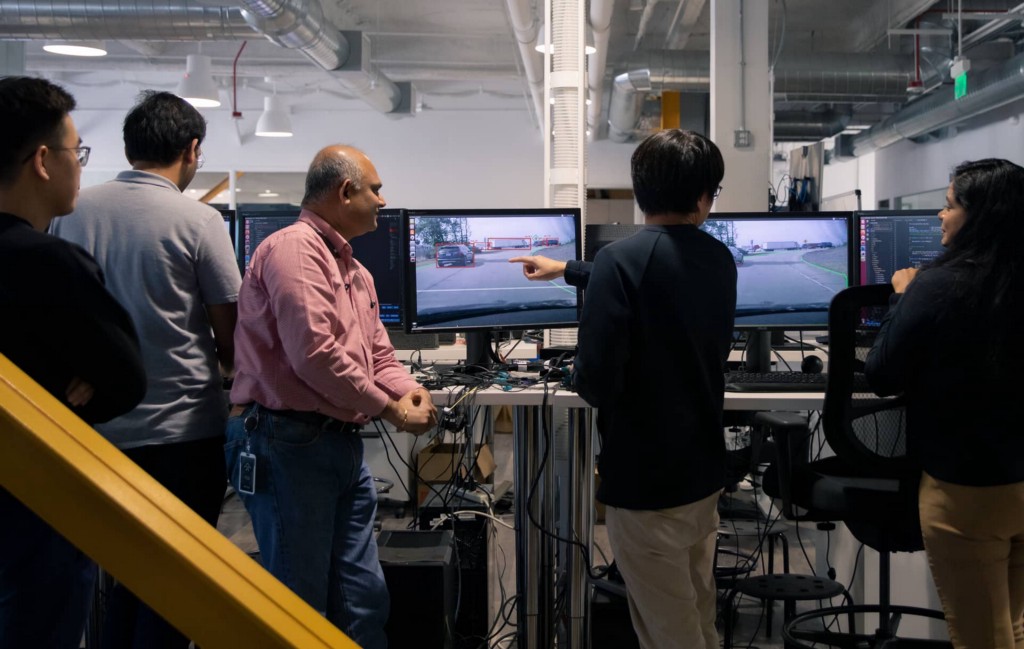In Tesla’s first Autonomy Day, one analyst from Los Angeles asked Elon Musk how the new Full Self-Driving Computer (FSD) would handle the infamous Los Angeles traffic. Mr. Musk, with his usual Jack Sparrow swagger, told him that he would be happy to consider including a “Los Angeles” mode in his future software update.
Well, it is quite appropriate for someone of Mr. Musk’s tall stature to target the Los Angeles freeway system so broadly. We at FF, however, have been focusing for quite some time about something a lot narrower — Interstate 405. Why not? Most Los Angelenos and the few unfortunate San Diegans, like myself, spend a big portion of our lifetimes on the 405. That is a story worth telling.
So, to tell the story, I chose as my stage, “CASE: Driving the Future”, an invitational event in Dublin, Ireland. The audience was notably international with only a couple of people having ever been on the 405. The 405 was my metaphor to explain how FF’s feature set is focused on improving the user’s experience while inside the vehicle, even when the vehicle is caught in a hopeless traffic jam. I told them that having an office three blocks from the 405 means we are all obsessed with the infamous freeway and it subconsciously affects our feature planning. Only in jest… maybe.
Wouldn’t we all love to be cozily nested in the zero-gravity rear seat of the FF 91 while it autonomously navigates bumper to bumper through the 13-mile Long Beach stretch which features five freeway interchanges, one airport exit, a gateway to North America’s busiest container port and at least three fender-benders at any given point in time? Add some calming mood lighting, in-seat massage and a live streaming Hans Zimmer concert video to that. Lakewood suddenly transforms into Ojai. Luckily, Waze’s screams about pulled over vehicles and objects on the road ahead are only audible to the poor soul sitting in the driver’s seat. Ah, autonomy, and luxury!!! What a dream?
“What level is it? When will you be at Level 4?”, a loud voice from the audience interrupted the dream. Level 4 defined by the Society of Automotive Engineers (SAE) as “High Driving Automation” where the vehicle essentially drives itself with no human intervention for extended periods of time. The vehicle’s operation may be limited to a specific route or geographic area and may only work under certain bright and clear weather conditions. Think of the Waymo Robotaxis in Phoenix which only recently have been able to operate commercially without a safety driver in them.
To achieve Level 4 autonomy today, a vehicle will need to pack on a few hundred thousand dollars of sensors — cameras, radars, LIDARs, etc. — and a computer system in the trunk that generates so much heat that it takes a heavy cooling system to keep it running. Did I mention the several hundred pounds of weight added to the vehicle that will lower the vehicle’s range drastically? Or the hundreds of watts of battery power this setup drains as it runs, also leading to drastic range reduction in an electric vehicle. Not to mention that the vehicle begins to look like an alien spacecraft from a 1960s movie, possibly affecting its aerodynamics too.
SAE Level 4, for the next few years, is for robotaxis. Mostly urban, relatively lower speeds and limited route flexibility.
Most passenger cars today are barely SAE Level 1. SAE Level 1 typically includes Adaptive Cruise Control and Automatic Emergency Braking while some Lane Keeping Features may also be considered Level 1. While many vehicle brands offer these features, they may often be pricey options that most buyers may skip to save costs. Some notable EV brands may not even offer these features to reduce the weight of the vehicle.
SAE Level 2 is usually Adaptive Cruise Control and Lane Center Control which work together to keep the vehicle in its lane and at a safe distance behind other vehicles for extended periods of time. The popular Tesla Autopilot and similar features from other brands are technically SAE Level 2 because the driver is still legally responsible for the safe operation of the vehicle. Vehicles enforce this driver alertness either by requiring the driver to keep their hands on the steering wheel or by monitoring the face of the driver. The human is always in-charge even if the vehicle is temporarily in control.

There are a lot of variations and user-friendliness features within SAE Level 2. For example, vehicles can automatically change lanes and hop from freeway to freeway in an automated manner with the help of navigation maps. These features make for a better Level 2 experience and do not necessarily add up to Level 3, where the vehicle takes full charge for at least part of the drive. Additional features can be added within SAE Levels 0, 1, and 2 to make the vehicle much safer, more comfortable, less stressful, and more enjoyable to be in.
Back to the I-405. It is primarily driver mistakes of varying severities that make the I-405 the biggest parking lot in SoCal. Several of the ubiquitous fender-benders that snare the freeway may be avoided by vehicles with a simple Adaptive Cruise Control and Automatic Emergency Braking combo. Lane Center Control in combination with Adaptive Cruise Control brings the driver to an almost-hands-free posture (emphasis on the “almost”.)
Anecdotally, even a very basic SAE Level 2 feature can dramatically improve the safety of the vehicle, as well as substantially reduce the stress on the driver. If every vehicle driving on the I-405 supported a reliable Level 2, the 405 would be a lot less snared and the drivers on it would be a lot less stressed. One can really witness this phenomenon among some drivers on the I-405 — the Zen look on their faces, reading their smartphone messages as their vehicle cruises through at 75 mph.
There are two important details to note.
One. Not all Level 2 autonomous systems are created equally. Adaptive Cruise Control can either deliver an elegant and smooth acceleration/deceleration/braking experience or a mad driver experience stomping alternatingly on the gas and brake pedals. Engineers have plenty of creative and design freedom to deliver the right experience for their customers. This also covers those additional enabling features such as automatic lane changes.
Two. Mr. Musk never talks to us about SAE Levels. He tells us what features will be in the next software update and how they will make the customer’s driving experience better. Is Full Self Driving an SAE Level 4 feature? The answer is “You can eventually sleep in the car”. I personally am a big fan of this approach.
At FF, our answer to the “What level is it?” question is, “We aim to deliver to you a very elegant and smooth autonomous driving experience on the FF 91 and beyond. We aim to deliver great features, not levels.” I choose to call it the 405 Mode.
At FF, we shall tip our hat to the I-405 every morning, looking forward to seeing FF vehicles autonomously navigate the I-405 enabling all the passengers to experience the great interior features we will deliver.
At FF, we look forward to a transformed, accident-free, gridlock-free Long Beach stretch, dominated by autonomous cars.
At FF, SAE Level 4 is not a barrier we will stress about. It will be conquered incrementally as we deliver great autonomy features across our vehicle lines.
About the Author

Shyam Sundar’s career spans from Smart Mobile Devices to Smart Mobility. He started his career at Qualcomm where he led the launch of several Android smartphones and tablets on Snapdragon processors. He bootstrapped and led Qualcomm’s first foray into Automotive Infotainment and built Qualcomm’s leadership in Android Automotive. He also led early-stage Autonomous Driving programs at NVIDIA.
At Faraday Future, Shyam leads Technology Product Management, covering Connected Infotainment Platform, ADAS/Autonomous Driving, and a number of forward-looking technology initiatives on the flagship FF 91. Shyam holds an M.S. in Computer Science from Wayne State University, Detroit, and an M.B.A. from UCLA Anderson. He is an avid speaker/panelist at Automotive Technology conferences. When he is not working on the technology, Shyam loves traveling to exotic locales and photographing them.
